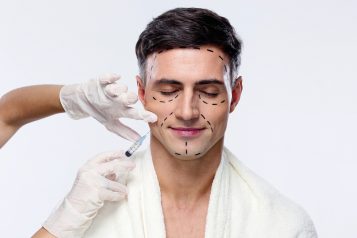Does the slimmer jawline of the most recent Snapchat filters have you dreaming of how you can look like that in day to day life? Haute Beauty talked to Dr. Shoib Myint who discusses the process of jaw contouring and how it can help perfect your jawline.

Haute Beauty: What is Jaw Contouring?
Dr. Shoib Myint: The trend in facial plastic surgery for 2019 and beyond has been “tweaks” and more natural, less invasive procedures. The patient clientele is concerned about “pre-juvenation” rather than rejuvenation. About 75% of patients consulting facial plastic surgeons are now in there 30’s. One particular area of concern is creating a more defining jawline. Jaw contouring can be achieved both surgically and non surgically. This contouring method is a process to achieve a slimmer, more defined jawline, as a sharper defined jawline is a sign of youth. It allows the frame of the face to achieve a more symmetrical appearance. The process is a bit different in women than men, as the end result for women is a smaller, narrower jawline, and in men a more square jawline. Both are what fashion and beauty dictate as being an attractive or beautiful face. Surgical jaw contouring can involve a facelift, neck lift, neck liposuction or adjusting the mandible (jaw bone) by reducing the bone or balancing the bone. Non-surgical options may include the following:
-Dermal fillers for jawline such as Juvederm, Radiesse, Restylane etc. Typically 1-2 syringes are needed.
-Neuromodulators such as Botox, Xeomin, or Desport. These drugs are injected into the Masseter muscle which sits on top of the jaw. Multiple injections over a few months can result in a slimmer face.
-Kybella injections to the face and neck can melt the fat particles around the jaw to accentuate the area making the jawline more visible. Multiple injections may be needed over a few months.
-Surgical threading can be used in the office to reshape and elevate the jawline. This procedure may need to be repeated depending on the patient.
-Radiofrequency, ultrasound, and in some cases a microneedling device.
HB: Who is Good Candidate For This Procedure?
SM: Most men and women are great candidates for the non-surgical methods with the few exceptions of any individual that is pregnant, has any underlying blood or bleeding disorders, has a history of chemotherapy or radiation and some other minor medical conditions. All prior medical history needs to be discussed with your doctor. Smokers also are at a high risk of poor wound healing.
HB: What Does Recovery Look Like?
SM: The recovery for the non-surgical approach is typically a few days, in some cases, recovery is only a few hours and you are ready to go out. Recovery time completely depends on the procedure type and the health of the patient. With injectables, there might be some bruising for 1-2 days, but most patients are back to work after this short period. For surgical procedures, there might be 1-2 weeks of downtime with bruising and swelling, and most patients return back to work after. For the face to look completely natural after a surgical procedure, it can take up to 3 months, but the results are fantastic. Typically after one week from the surgery makeup can be applied, much quicker for the non-surgical approach.
HB: Do Men Also Benefit From the Procedure?
SM: The percentage of men undergoing facial aesthetic procedures are on the rise. The jawline is one of the top reasons they seek facial plastic surgery consultations. Most men prefer non-surgical procedures with little to no downtime. This trend will continue to rise in the future.
HB: How Are The Results Best Maintained?
SM: As with any plastic surgery procedure, invasive or noninvasive, there are healing properties that are set in motion for all of us to heal from these procedures. Some of these healing properties are built-in, meaning the way our cells behave and function to heal. Healing modalities can be administered externally to help a patient heal faster. Both internal and external healing aids play an important role in scar formation, bruising and swelling. Maintaining the results will depend on the patient’s dedication to ensuring a well-rounded healing regimen. Some of the things patients can do to help the healing process are: ensuring proper nutrition and skincare. Making sure these two things are optimally maintained provides the biggest bang for the buck after procedures. Unless implants are placed in the face, my opinion is that nothing is permanent. No procedure can last forever because our faces are multidimensional and constantly in motion. After a few years, gravity will settle in and tissues will mobilize and change again. When it is time for a repeat procedure, the type of procedure can be discussed with your doctor. Regardless, beauty is a maintenance endeavor and all patients need to understand that.
For more information, please visit www.drmyint.com.
For more information, visit Dr. Brian A. Levine's social media:

























